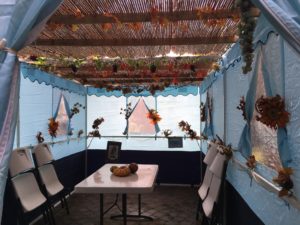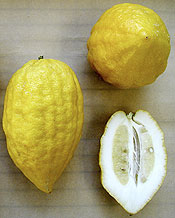We are deep into the holidays! We have come out of Rosh Hashanah & Yom Kippur and headed straight into Sukkot. I finished putting up my sukkah (talk about a “floor, but no ceiling”!) last night and look forward to picking up my children from school today and finishing the decorations together as a family.
This is absolutely my favorite holiday of the entire year. There is nothing else like it on the Jewish Calendar – sitting outside in a sukkah you built yourself (which is pretty much the one and only thing I actually can and do build), with handmade decorations from your children, enjoying good food with friends and family in the night air, the citrusy smell of etrog lingering and mixing with verdant lulav – this is experiential Judaism at its finest.
else like it on the Jewish Calendar – sitting outside in a sukkah you built yourself (which is pretty much the one and only thing I actually can and do build), with handmade decorations from your children, enjoying good food with friends and family in the night air, the citrusy smell of etrog lingering and mixing with verdant lulav – this is experiential Judaism at its finest.
But here is a complicated truth: Even though our school will be closed on Thursday and Friday for Sukkot, it is reasonable to assume that a significant number of our students will neither be found in a synagogue nor a sukkah enjoying what is known as “The Season of our Rejoicing”. But I’d wager that many, if not most, were in synagogue last weekend for Yom Kippur. So when it comes to “atoning” we have a full house, but for “rejoicing” we have empty seats?
If our children – if we – only experience the Judaism of Rosh Hashanah and Yom Kippur and not the Judaism of Sukkot, the simple truth is that we are not exposing them to the full range of beauty and joy our tradition has to offer. So why, in fact, is this a common occurrence?
 I’m not entirely sure, but I think it has to do with the exotic nature of the holiday. As someone who did not grow up celebrating this holiday, upon coming to synagogue as an adult and watching a congregation march in circles waving fruits and vegetables – well this was not the Judaism I knew! Truth be told, there are surely pagan accretions to the way that we honor the harvest roots of this holiday which may seem alien to the typical prayerbook service. But for me, that is precisely what makes it so unique, special and not-to-be-missed!
I’m not entirely sure, but I think it has to do with the exotic nature of the holiday. As someone who did not grow up celebrating this holiday, upon coming to synagogue as an adult and watching a congregation march in circles waving fruits and vegetables – well this was not the Judaism I knew! Truth be told, there are surely pagan accretions to the way that we honor the harvest roots of this holiday which may seem alien to the typical prayerbook service. But for me, that is precisely what makes it so unique, special and not-to-be-missed!
No one likes to feel uncomfortable and adults, especially, are wary of feeling uneducated or unprepared. I know how I felt encountering Jewish ritual for the first time as an adult – it was scary. I, however, was lucky. I was pursuing a degree in Jewish education and, therefore, had all the support and resources I needed to learn and grow. I realize that most adults coming at Jewish practice for the first time (or the first time in a while) are not so lucky. The amount of “stuff” Judaism asks of us to do – building the sukkah with precise specifications, shaking the lulav and etrog in the proscribed way, chanting less-familiar prayers, coming to synagogue on unfamiliar days – can be overwhelming.
But don’t lose the forest through the trees…
I’d simply ask you to consider this: When building your child’s library of Jewish memories, which memory feels more compelling and likely to resonate over time – sitting in starched clothes in sanctuary seats or relaxing with friends and family in an outdoor sukkah built with love and care?
You don’t have to choose just one, of course, that is the beauty of living a life of sacred time – there is a rhythm to the Jewish calendar, evocative and varied. Come to synagogue for the High Holidays, to be sure. But don’t miss out on Sukkot (or Simchat Torah or Shavuot or “Add Jewish Holiday Here”). Let this Sukkot truly be the season of our great rejoicing. I hope many students find their way to synagogue and into sukkot this Sukkot. I hope many parents push themselves out of their comfort zones and join the parade. I hope in future years that OJCS will take a more active role in providing families with the tools they may need to get started through parent workshops and community sukkah-building parties. But if you are curious or inspired…go ahead…pick up your fruit and vegetables and march with us!
Chag sameach.

